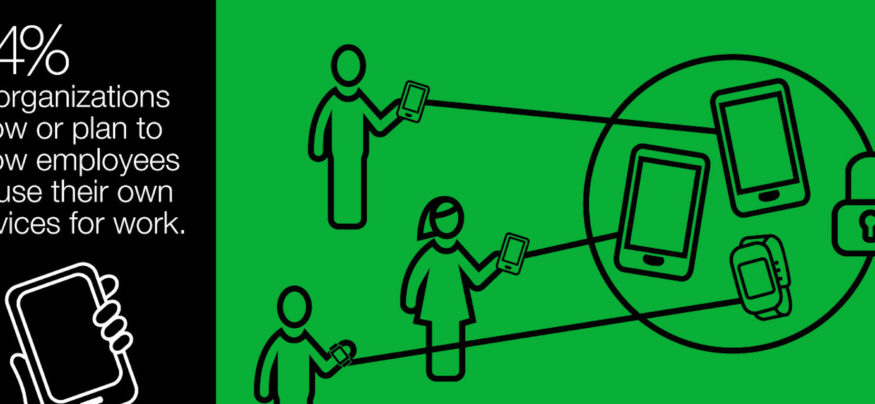Enterprise mobility management (EMM) platforms are growing fast in popularity. One of the main drivers behind this has been the rise in bring-your-own-device (BYOD) policies, whereby organizations allow employees to use their personal devices in the workplace. According to a recent survey by Tech Pro Research, reported by ZDNet, 74 percent of organizations are already allowing or are planning to allow employees to use their own devices for work. With such devices effectively outside of the control of the IT department, organizations need to find a way to effectively manage their use, reducing the risk for security and compliance issues.
Early Controls: Mobile Device Management
The earliest controls available on the market were mobile device management (MDM) solutions that focused primarily on the device itself. They were mainly based on applying policies, enabling BYOD by controlling access to resources at the device level. However, many businesses felt that some MDM did not offer the full range of security, policy and compliance features required to be truly able to manage mobile devices in a corporate environment.
Along with hardware-level management that controls what devices are on the network, organizations were looking for the ability to manage the applications and content consumed. Businesses are now focusing on protecting sensitive data wherever it resides, and to do that, IT must be able to control all potential access points. Content is especially vulnerable because it presents an entryway for unauthorized access. By moving from a device-centric approach to one focused on data, organizations will be much better placed to safeguard their information.
To cater to these needs as they arose, mobile application management (MAM) and mobile content management (MCM) technologies were introduced to fill MDM’s gaps. However, MDM, MAM and MCM technologies were generally delivered as standalone products with no common management or reporting capabilities. This meant that IT often had a difficult time managing disparate information.
The Move to Integrated Enterprise Mobility Management Platforms
EMM platforms are an evolution of MDM. They combine the capabilities of MDM, MAM and MCM with security and compliance into one integrated platform with a common management interface and reporting capabilities. Further, EMM responds to organizations’ needs by providing more comprehensive mobility management tools that manage the entire workspace, not just the device. According to a 2015 report by Gartner, businesses need such a tool because the use cases for mobile applications and the diversity of mobile platforms have expanded. Employees use mobile devices for their flexibility, ease of use and productivity, which greatly help when accessing emails, documents and Web-based information.
Along with general productivity, the use of vertical-based, industry-specific mobile apps is also increasing, many of which are developed by a third party. Gartner found that currently 40 percent of organizations are making use of vertically oriented tools. Among its findings are that 59 percent of organizations are using such tools to manage internally developed applications and 56 percent are managing third-party apps delivered through internal app stores. Additionally, 58 percent are supporting apps available through public app stores.
What to Look for in an Enterprise Mobility Management Platform
A comprehensive EMM platform should provide all the capabilities that are required for mobile deployment, including device-, application- and content-level control, in a single unified platform. In terms of device control, it should be able to moderate what devices are allowed on the network according to their security posture. It should also provide support for all operating systems and devices, including laptops as well as new devices as they come onto the market.
For managing applications and data, Enterprise Mobility Management technology includes containerization for separating work and personal data, and it also connects to an enterprise app store from which users can pull preapproved programs according to internal policies. Application control features allow organizations to manage what is installed on devices, offering the ability to edit, delete or push apps to users.
For administration and user management, organizations can enable single sign-on for users via a personal console, through which employees can access the apps and data for which they have permissions. User identities can be tied to and verified by corporate directories, whether on-premises or in the cloud, and strong authentication can restrict access to sensitive resources. Similarly, all user activity may be logged for auditing and reporting purposes. To ease administration, EMM platforms often have one central management console through which IT can accomplish maintenance tasks, enforce policies and track integrated reporting and analytics. Most platforms can also integrate with an organization’s existing infrastructure so that existing policies can be extended to mobile devices.
EMM technology promises to improve capabilities for managing the entire mobile ecosystem, enabling organizations to better control which devices connect to the network and what applications, data and services employees consume. Mobile devices are almost ubiquitous among consumers and are becoming more so in the enterprise. With the right controls in place, organizations will be better placed to benefit from mobility’s opportunities while ensuring that sensitive information and resources are safeguarded.
Want to find out more about what to look for in a comprehensive EMM solution? Read this whitepaper from Frost & Sullivan.





